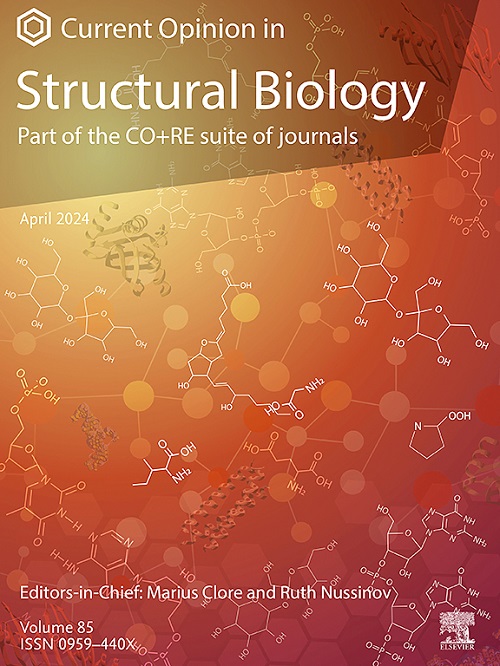Are N-linked glycans intrinsically disordered?
IF 6.1
2区 生物学
Q1 BIOCHEMISTRY & MOLECULAR BIOLOGY
引用次数: 0
Abstract
The covalent attachment of oligosaccharides to asparagine side chains on protein surfaces (N-linked glycosylation) is a ubiquitous modification that is critical to protein stability and function. Experimental 3D structures of glycoproteins in which the N-linked glycans are well resolved are rare due to both the presumed flexibility of the N-linked glycan and to glycan microheterogeneity. To surmount these limitations, computational modeling is often applied to glycoproteins, particularly to generate an ensemble of 3D shapes for the N-linked glycans. While the number of glycoprotein modelling tools continues to expand, the available experimental data against which the predictions can be validated remains extremely limited. Here, we present our current understanding of the dynamic properties of N-linked glycans, with a particular focus on features that impact their presentation (orientation) relative to the protein surface. Additionally, we review the limits of experimental and theoretical studies of glycoproteins, and ask the question, “Are N-linked glycans intrinsically disordered?”.
n链聚糖本质上是无序的吗?
低聚糖与蛋白质表面天冬酰胺侧链的共价连接(n -链糖基化)是一种普遍存在的修饰,对蛋白质的稳定性和功能至关重要。在糖蛋白的实验三维结构中,由于假定的n -连接的聚糖的灵活性和聚糖的微异质性,n -连接的聚糖被很好地分解是罕见的。为了克服这些限制,计算建模经常应用于糖蛋白,特别是为n链聚糖生成三维形状的集合。虽然糖蛋白建模工具的数量在不断增加,但用于验证预测的可用实验数据仍然非常有限。在这里,我们介绍了我们目前对n链聚糖的动态特性的理解,特别关注影响它们相对于蛋白质表面的呈现(取向)的特征。此外,我们回顾了糖蛋白的实验和理论研究的局限性,并提出了一个问题,“n -链聚糖本质上是无序的吗?”
本文章由计算机程序翻译,如有差异,请以英文原文为准。
求助全文
约1分钟内获得全文
求助全文
来源期刊

Current opinion in structural biology
生物-生化与分子生物学
CiteScore
12.20
自引率
2.90%
发文量
179
审稿时长
6-12 weeks
期刊介绍:
Current Opinion in Structural Biology (COSB) aims to stimulate scientifically grounded, interdisciplinary, multi-scale debate and exchange of ideas. It contains polished, concise and timely reviews and opinions, with particular emphasis on those articles published in the past two years. In addition to describing recent trends, the authors are encouraged to give their subjective opinion of the topics discussed.
In COSB, we help the reader by providing in a systematic manner:
1. The views of experts on current advances in their field in a clear and readable form.
2. Evaluations of the most interesting papers, annotated by experts, from the great wealth of original publications.
[...]
The subject of Structural Biology is divided into twelve themed sections, each of which is reviewed once a year. Each issue contains two sections, and the amount of space devoted to each section is related to its importance.
-Folding and Binding-
Nucleic acids and their protein complexes-
Macromolecular Machines-
Theory and Simulation-
Sequences and Topology-
New constructs and expression of proteins-
Membranes-
Engineering and Design-
Carbohydrate-protein interactions and glycosylation-
Biophysical and molecular biological methods-
Multi-protein assemblies in signalling-
Catalysis and Regulation
 求助内容:
求助内容: 应助结果提醒方式:
应助结果提醒方式:


